NEC PA301w: The Baddest 30-inch Display Around
by Brian Klug on March 1, 2011 8:00 AM ESTViewing Angles
I almost don't need to say it, but the PA301w has superb viewing angles just as advertised. In both the horizontal and vertical directions, there's almost no distortion until viewed at the most extreme of angles. There's a bit more sensitivity in the vertical direction, but the difference is essentially insubstantial. Using the display in portrait is actually just an awesome testament to how good those viewing angles are - it's completely useable with no annoyances.
It's actually mind-blowing to use something this vertical to browse the net for even a few hours.
Color Quality
Next up are the ever-important color quality metrics. As usual, we report two main quality metrics: color accuracy (Delta-E) and color gamut. Color gamut refers to the range of colors the display is able to represent with respect to some color space. In this case, our reference is the AdobeRGB 1998 color space, which is larger than the sRGB color space. Our percentages are thus reported with respect to AdobeRGB 1998, and larger is generally better unless you're dealing with sRGB content and colorspace-unaware software.
Color accuracy (Delta E) refers to the display’s ability to display the correct color requested by the GPU and OS. The difference between the color represented by the display, and the color requested by the GPU is our Delta-E, and lower is better here. In practice, a Delta E under 1.0 is perfect - the chromatic sensitivity of the human eye is not great enough to distinguish a difference. Moving up, a Delta E of 2.0 or less is generally considered fit for use in a professional imaging environment - it isn’t perfect, but it’s hard to gauge the difference. Finally, Delta E of 4.0 and above is considered visible with the human eye. Of course, the big consideration here is frame of reference; unless you have another monitor or some print samples like a Gretag Macbeth color checker card to compare your display with, you might not notice.
As I mentioned in our earlier reviews, we’ve updated our display test bench. We’ve deprecated the Monaco Optix XR Pro colorimeter in favor of an Xrite i1D2 since there are no longer up-to-date drivers for modern platforms. We're trying to find an i1Pro to use as well.
For these tests, we calibrate the display and try to obtain the best Delta-E we can get at both 200 nits of brightness for normal use, and 100 nits for print brightness. We target D65 and a gamma of 2.2, but sometimes the best performance lies at native temperature and another gamma, so we try to find what absolute absolute best-case performance for each display. We also take an uncalibrated measurement to show performance out of the box using either the manufacturer supplied color profile, or a generic one with no LUT data. For all of these, dynamic contrast is disabled, and displays are left to settle for a half hour after making changes. The PA301w is CCFL-backlit, and I used a settle time of 30 minutes accordingly.
With the PA301w, I used the internal calibration routine to get me close, and then HCFR and the advanced OSD to get the color tristimulus primary values perfect. Then I calibrated with ColorEyes Display Pro.
First up is uncalibrated Delta-E performance. For this test, I took the monitor out of the box, connected it over DisplayPort, adjusted to 200 nits, and ran our usual GMB color checker test.
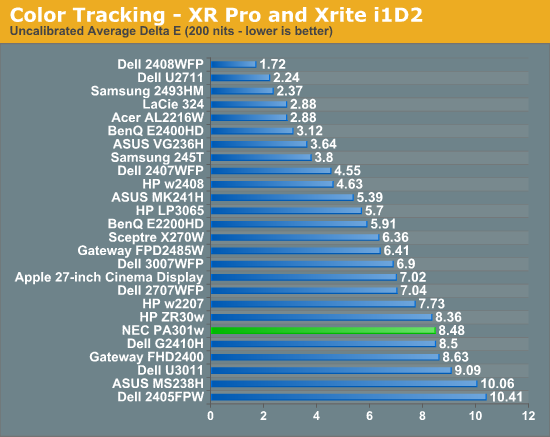
I took our uncalibrated test literally and ran this before using internal calibration either. Unsurprisingly, results aren't very good, and we see pretty middling performance out of the PA301w without any calibration. That said, if you're getting a professional monitor, you're hopefully going to calibrate it so you can actually enjoy what you're paying for. I didn't test, but running the in-monitor calibration alone has to help this out somewhat.
Moving on to the important 200 nit calibrated results, we can see the PA301w do very well, but still not displace the HP ZR30w result. I spent a lot of time trying to squeeze everything I could out of the PA301w and Delta E of 1.09 was as good as things would get. The result is still very good, I was just hoping to see something below 1.0 across the board like Jarred used to consistently. I'm beginning to suspect the i1D2 simply isn't as good of an instrument as the XR Pro, and what we're seeing is just instrumentational error creep in.
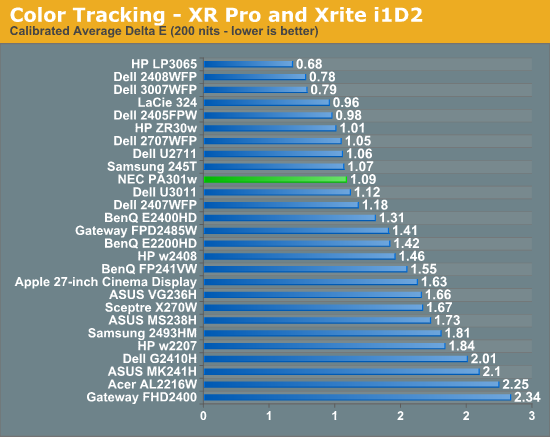
The PA301w doesn't have the typical spiky peaks that other displays which lack RGB controls show, which is great to see. You can see that the ZR30w still leads in some places, though the PA301w is clearly better in the greys.
At 100 nits, the PA301w pulls away and narrowly edges out the rest of the 30-inchers. Again, we still don't get a result that's under 1.0, but the numbers are obviously good enough for professional use.
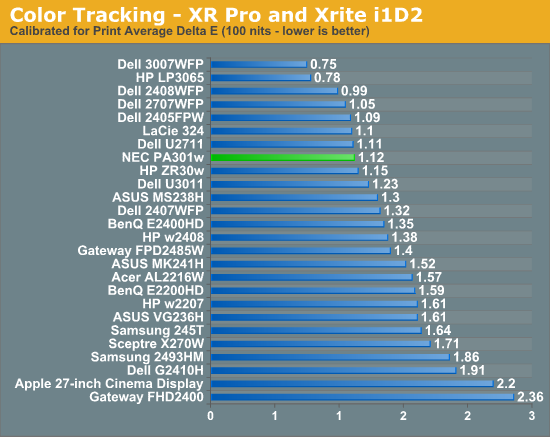
I'm impressed with color tracking on the PA301w and honestly think it can do better if we had an i1Pro spectroradiometer. I'm trying to get our hands on a good one, so we might just see it soon for these more serious display reviews.
Gamut percentage is important as well, and this is the only real place I think the U3011 has a distinct advantage. The PA301w has a "FULL" picture setting preset in the OSD which seems to change the red green and blue values to the edge of the display's supported gamut size. You can adjust further, however the labels turn pink which indicates that they're outside of the gamut. I went with full and took a reading, as expanding manually beyond didn't change the value any further. We can also see that the sRGB mode really clamps down on gamut percentage, and definitely works. There's also an AdobeRGB mode and a number of other common color spaces included. The PA301w uses an internal LUT to map color.
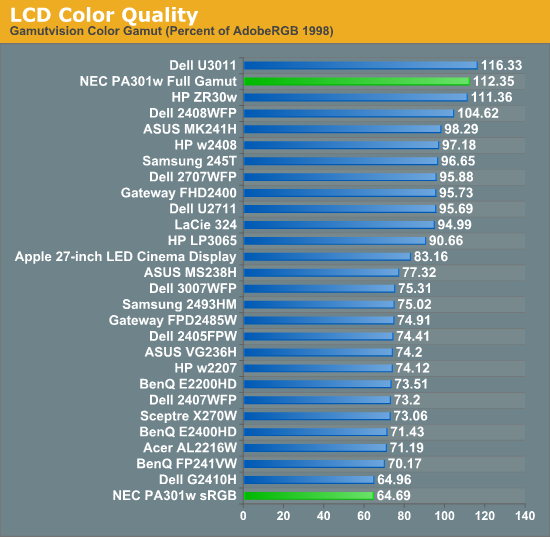









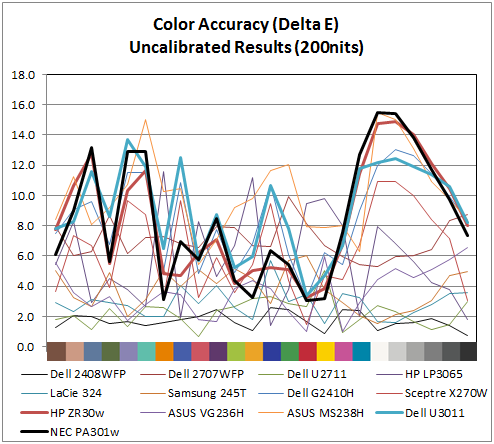
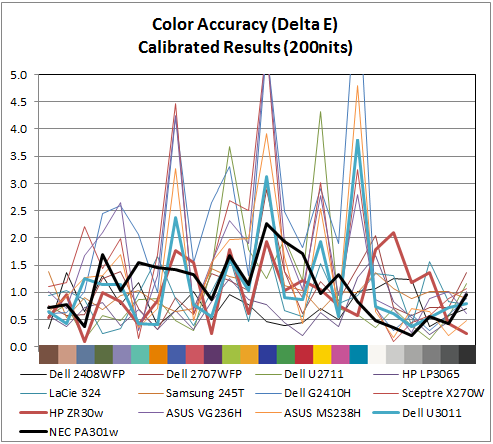









92 Comments
View All Comments
Seanrus - Wednesday, March 2, 2011 - link
This is first time on andtech that I've read a review that I would consider clearly biased. I follow development of 30 inch monitors closely for a last couple of years, since I want one but not yet committed to it.My reasoning is that in final thought writer, at least, should have mentioned about the relative price point to other 30" monitors. If that was done it would be clear that this monitor does not fit well anywhere in the market of 30" monitors.
Just bellow it, in performance, is HP ZR30 w which is can be acquired for $1100-1200 (for half the price) and performs very closely to this NEC.
As result the only consumers that might consider this monitor for whom the price is not the option, but then there are monitors in 5K range that perform even better than this one.
Also from the gamer perspective, which I speculate is the biggest audience here, ZR30w probably will be a better choice, because NEC, most likely, will not perform as well on response time as ZR30w since NEC has OSD (and that slows down response time as described in recent dell 30" monitor review.) This is a speculation and we need to wait for the results for response time to be posted.
Finally, I got an impression from this article that being big and heavy is a good thing (unfortunately I do not think phrase form Snatch "If it does not work, you can hit with it" would apply here.) Even the title of the article emphasizes that. This big and heavy quality of the monitor is defensibly a drawback, especially when it is 20lb heavier than other 30" monitors.
Conclusion that I came to from this article is that this monitor is nothing to be excited about, and is not a good buy for any consumer/prosumer segment. Performance benefits, and extra features that this NEC monitor has do not justify a $1000 premium.
strikeback03 - Wednesday, March 2, 2011 - link
It is a product marketed at a professional audience, with a price and some features to match. Many people have been wondering how the "cheap" 30" displays compare to some of the options targeted at professionals, now they have a comparison. Yes, gamers are better off buying a cheaper one.erple2 - Wednesday, March 2, 2011 - link
I got the gist not that being big and heavy was a good thing, but that it wasn't a bad thing.bossanova808 - Thursday, March 3, 2011 - link
If the colour accuracy stuff in this review had been done properly, then you would have seen the NEC way out in front of the HP and, for the target market, that's pretty important. Not saying the HP doesn't make sense for gamers, but for the pro image makers that NEC are targetting, the PA30 is a spectacular device from a performance/price point of view when compared to it's real competition which is the CG303W from Eizo (and that's about it).8steve8 - Wednesday, March 2, 2011 - link
no LED illumination = no buybossanova808 - Thursday, March 3, 2011 - link
A disaster from a colour accuracy persepctive, hence no LED as it's not appropriat for the target market - same as EIzo don't do LED monitors.Soldier1969 - Wednesday, March 2, 2011 - link
with these days of half inch thick led panels this thing looks like something from 6 or 7 years ago. $2300 not thanks. Im just fine with my 30" HP ZR30w super ips panel you last reviewed. Works great and im still in awe of it with gaming and daily use. $1200 much better spent.lemonadesoda - Wednesday, March 2, 2011 - link
Yes, this is a nice 2560x1600 30"er.But where is the innovation? Where are the higher pixel density displays. Those that want 2560x1600 displays but in a more manageable 24" or 27" format?
And what about ultra-hi resolution like 3840x2160 in 27"? Allowing you to read documents/PDFs in near-print DPI quality. Why is no-one making these?. the panels ARE available! http://www.chimei-innolux.com/opencms/cmo/products...
tzhu07 - Thursday, March 3, 2011 - link
I currently own the NEC PA271W, the little brother to this monitor. I kind of prefer the 271 over the 301 because it has a finer dot pitch, therefore I don't have to move my head around as much. You do lose 160 horizontal lines, but it's really not too much of a big deal. It's the best monitor I've used so far.Those with poorer eye sight though should get the 301.
Beka - Thursday, March 3, 2011 - link
Does this nec screen have a good scaler like the dell?Being able to play at lower resolution while having games that still look good is great feature of the dell.